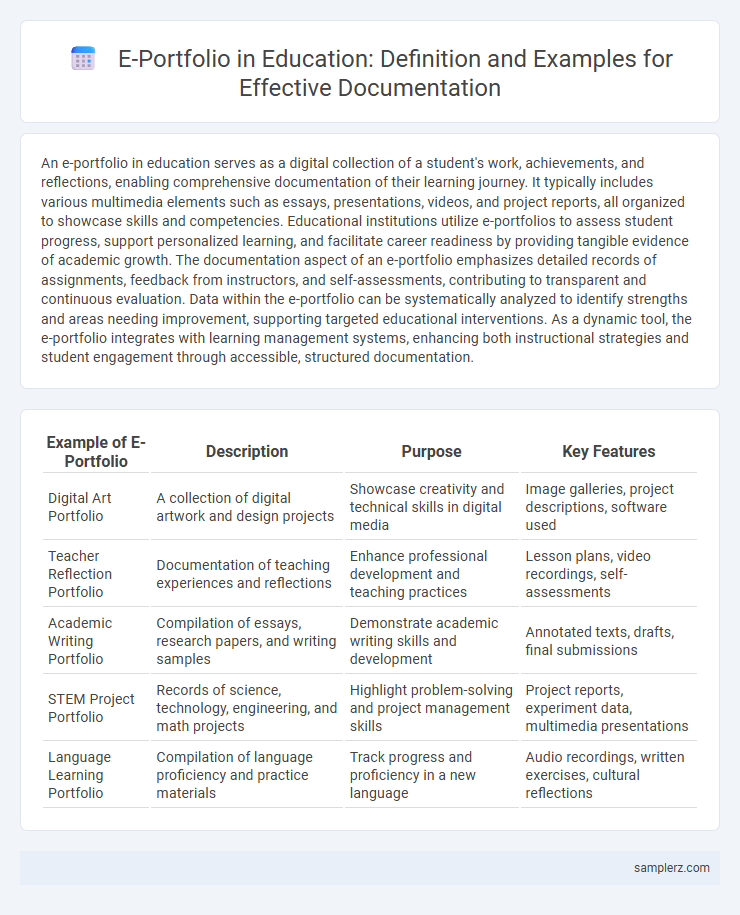An e-portfolio in education serves as a digital collection of a student's work, achievements, and reflections, enabling comprehensive documentation of their learning journey. It typically includes various multimedia elements such as essays, presentations, videos, and project reports, all organized to showcase skills and competencies. Educational institutions utilize e-portfolios to assess student progress, support personalized learning, and facilitate career readiness by providing tangible evidence of academic growth. The documentation aspect of an e-portfolio emphasizes detailed records of assignments, feedback from instructors, and self-assessments, contributing to transparent and continuous evaluation. Data within the e-portfolio can be systematically analyzed to identify strengths and areas needing improvement, supporting targeted educational interventions. As a dynamic tool, the e-portfolio integrates with learning management systems, enhancing both instructional strategies and student engagement through accessible, structured documentation.
Table of Comparison
| Example of E-Portfolio | Description | Purpose | Key Features |
|---|---|---|---|
| Digital Art Portfolio | A collection of digital artwork and design projects | Showcase creativity and technical skills in digital media | Image galleries, project descriptions, software used |
| Teacher Reflection Portfolio | Documentation of teaching experiences and reflections | Enhance professional development and teaching practices | Lesson plans, video recordings, self-assessments |
| Academic Writing Portfolio | Compilation of essays, research papers, and writing samples | Demonstrate academic writing skills and development | Annotated texts, drafts, final submissions |
| STEM Project Portfolio | Records of science, technology, engineering, and math projects | Highlight problem-solving and project management skills | Project reports, experiment data, multimedia presentations |
| Language Learning Portfolio | Compilation of language proficiency and practice materials | Track progress and proficiency in a new language | Audio recordings, written exercises, cultural reflections |
Introduction to E-Portfolios in Educational Documentation
E-portfolios serve as dynamic digital repositories that document students' learning progress, skills, and achievements over time. These platforms enable educators and learners to collect, reflect on, and showcase evidence such as assignments, presentations, and assessments in a structured and accessible format. Incorporating multimedia elements and self-assessment tools, e-portfolios enhance personalized learning and provide a comprehensive view of academic development.
Key Components of an Effective E-Portfolio
An effective e-portfolio in education includes key components such as a clear personal statement, curated artifacts demonstrating skills and achievements, and reflective commentary linking experiences to learning outcomes. Interactive elements like multimedia presentations and hyperlinks to project work enhance engagement and showcase diverse competencies. Secure, user-friendly navigation and consistent formatting ensure easy access and professional presentation for both students and educators.
Examples of E-Portfolios for Student Assessment
E-portfolios for student assessment often include diverse multimedia artifacts such as research papers, project videos, and reflective journals that demonstrate learning progress and skill mastery. Platforms like Google Sites, Seesaw, and Mahara enable students to organize and showcase work across subjects, facilitating comprehensive evaluations by educators. These digital portfolios support competency-based assessments by providing authentic evidence of student performance over time.
Showcasing Learning Progress with Digital Portfolios
Digital portfolios effectively showcase learning progress by compiling multimedia artifacts such as assignments, reflections, and project outcomes in a centralized online platform. Tools like Google Sites, Seesaw, and Mahara enable students to visually document growth over time while offering educators easy access to monitor development. This dynamic evidence-based approach enhances personalized feedback and supports continuous improvement in educational settings.
E-Portfolios as Tools for Reflective Practice
E-portfolios serve as dynamic tools for reflective practice by enabling students to document learning experiences, track progress, and showcase achievements in a digital format. They incorporate multimedia elements such as written reflections, videos, and project artifacts to deepen self-assessment and critical thinking. This documentation supports continuous improvement by providing educators and learners with comprehensive insights into personal and academic growth.
Best Practices in E-Portfolio Documentation
Effective e-portfolio documentation incorporates clear evidence of competencies, organized artifacts like project summaries, reflective narratives, and multimedia elements aligned with learning objectives. Best practices include consistent formatting, regular updates, and integration of feedback to demonstrate growth and skill mastery within educational frameworks. Utilizing metadata and tagging enhances searchability and allows educators to assess student progress efficiently.
Integrating Multimedia Evidence in E-Portfolios
Integrating multimedia evidence in e-portfolios enhances documentation by incorporating videos, audio recordings, images, and interactive presentations that showcase a student's skills and learning progress. For example, a teacher candidate might include recorded lesson demonstrations alongside reflective writing and project artifacts to provide a comprehensive view of their teaching capabilities. This multimedia integration supports diverse learning styles and offers a dynamic, engaging way to validate competencies and achievements.
Utilizing E-Portfolios for Collaborative Projects
E-portfolios enable seamless documentation and sharing of collaborative projects by allowing students to upload multimedia files, reflect on group processes, and track collective progress in real time. Platforms like Google Sites, Mahara, and PebblePad support collaborative features such as shared folders, commenting, and version control, fostering active peer engagement. Utilizing e-portfolios enhances teamwork skills and provides educators with comprehensive evidence of group learning outcomes for assessment and feedback.
E-Portfolios in Teacher Professional Development
E-Portfolios in teacher professional development serve as dynamic repositories that document educators' lesson plans, reflections, and assessments, showcasing their growth and instructional strategies over time. These digital portfolios integrate multimedia elements such as videos of classroom teaching, student feedback, and professional certifications, providing comprehensive evidence of teaching competencies. By facilitating continuous self-assessment and peer collaboration, e-portfolios enhance reflective practice and support targeted professional learning goals.
Evaluating the Impact of E-Portfolios on Education
E-portfolios enable comprehensive documentation of student progress, allowing educators to assess critical thinking, creativity, and skill development over time. Research shows that integrating e-portfolios enhances student self-reflection and promotes personalized learning pathways, improving retention and academic performance. Data from case studies reveal increased engagement and deeper learning outcomes when e-portfolios are systematically evaluated and incorporated into assessment strategies.

example of e-portfolio in documentation Infographic
 samplerz.com
samplerz.com